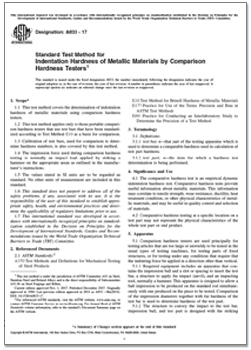英文名称:
ASTM A833-17
Standard Test Method for Indentation Hardness of Metallic Materials by Comparison Hardness Testers
中文名称:
ASTM A833-17
用对比硬度计测试金属材料压痕硬度的标准试验方法
标准状态:已作废,被ASTM A833-19替代
代号说明:
This standard is issued under the fixed designation A833; the number immediately following the designation indicates the year of
original adoption or, in the case of revision, the year of last revision. A number in parentheses indicates the year of last reapproval. A
superscript epsilon (ε) indicates an editorial change since the last revision or reapproval.
版本说明:
1 This test method is under the jurisdiction of ASTM Committee A01 on Steel,
Stainless Steel and Related Alloys and is the direct responsibility of Subcommittee
A01.06 on Steel Forgings and Billets.
Current edition approved Nov. 1, 2017. Published December 2017. Originally
approved in 1984. Last previous edition approved in 2014 as A833 – 08a(2014).
DOI: 10.1520/A0833-17.
2 For referenced ASTM standards, visit the ASTM website, www.astm.org, or
contact ASTM Customer Service at service@astm.org. For Annual Book of ASTM
Standards volume information, refer to the standard’s Document Summary page on
the ASTM website.
标准正文:
1. Scope
1.1 This test method covers the determination of indentation
hardness of metallic materials using comparison hardness
testers.
1.2 This test method applies only to those portable compari-
son hardness testers that use test bars that have been standard-
ized according to Test Method E10 as a basis for comparison.
1.3 Calibration of test bars, used for comparison to deter-
mine hardness numbers, is also covered by this test method.
1.4 The impression force used during comparison hardness
testing is normally an impact load applied by striking a
hammer on the appropriate areas as outlined in the manufac-
turer’s instructions.
1.5 The values stated in SI units are to be regarded as
standard. No other units of measurement are included in this
standard.
1.6 This standard does not purport to address all of the
safety problems, if any, associated with its use. It is the
responsibility of the user of this standard to establish appro-
priate safety, health, and environmental practices and deter-
mine the applicability of regulatory limitations prior to use.
1.7 This international standard was developed in accor-
dance with internationally recognized principles on standard-
ization established in the Decision on Principles for the
Development of International Standards, Guides and Recom-
mendations issued by the World Trade Organization Technical
Barriers to Trade (TBT) Committee.
2. Referenced Documents
2.1 ASTM Standards:
A370 Test Methods and Definitions for Mechanical Testing
of Steel Products
E10 Test Method for Brinell Hardness of Metallic Materials
E177 Practice for Use of the Terms Precision and Bias in
ASTM Test Methods
E691 Practice for Conducting an Interlaboratory Study to
Determine the Precision of a Test Method
3. Terminology
3.1 Definitions:
3.1.1 test bar, n—that part of the testing apparatus which is
used to determine a comparable hardness used in calculation of
test part hardness.
3.1.2 test part, n—the item for which a hardness test
determination is being performed.
在线阅读 免费下载







